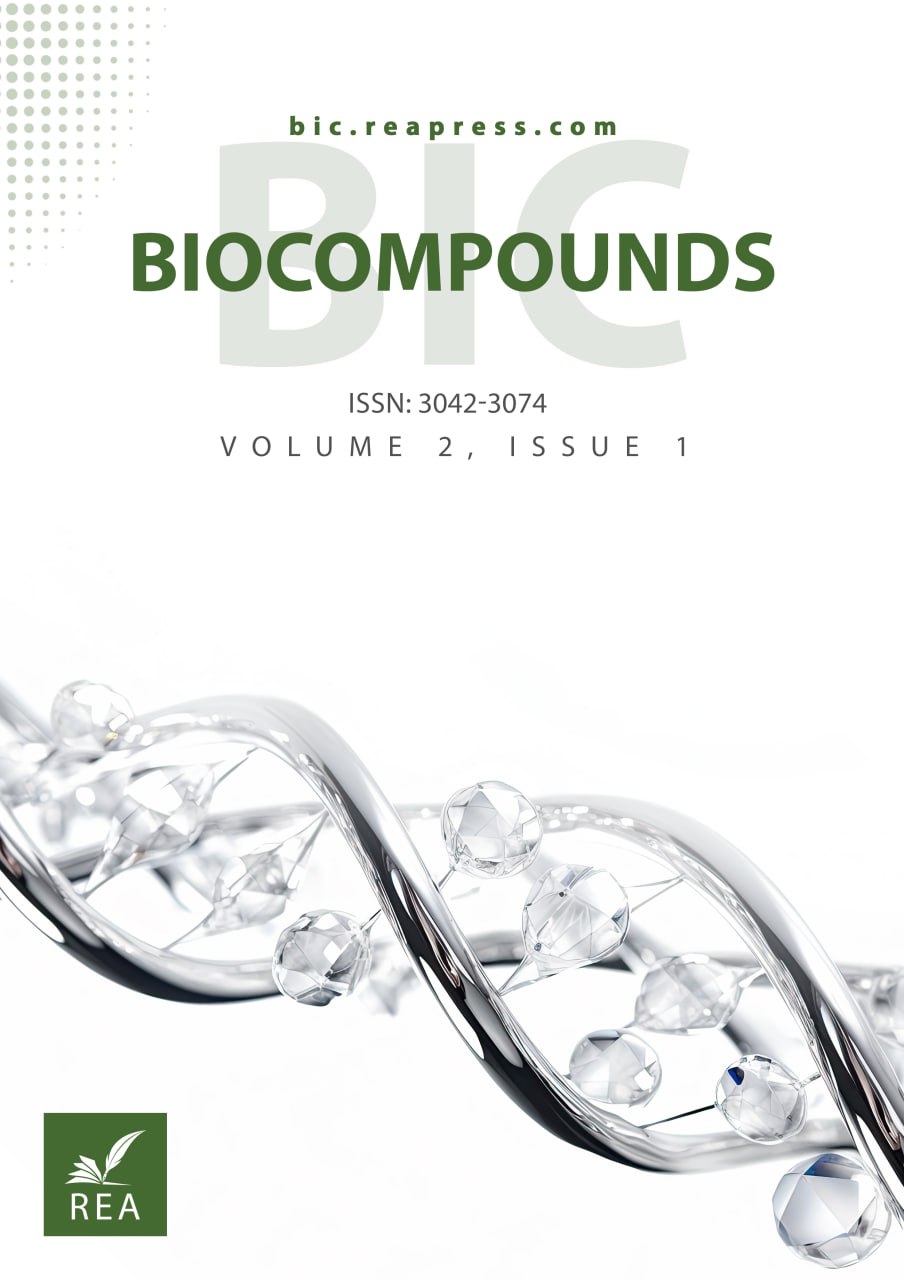Evaluation of Antioxidant Constituents and Cytotoxic Effects of Rumex Tuberosus Leaf Extract on Colorectal Cancer Cells
Abstract
Colon cancer is one of the most common causes of mortality worldwide and has been identified as the second leading cause of cancer-related deaths among adults. Therefore, there is an urgent need to control this malignancy using therapeutic approaches with minimal side effects. The present study aimed to identify the antioxidant compounds in the leaf extract of (Rumex Tuberosus) and to evaluate its inhibitory effects on the growth of colorectal cancer cells. For this purpose, the leaves of R. Tuberosus were collected from Tonekabon, air-dried in the shade, and ground into powder. The extracts were prepared by maceration, and the total phenolic, flavonoid, and anthocyanin contents were determined. The HT29 colorectal cancer cell line was cultured and treated with various concentrations of the leaf extract (ranging from 62.5 to 2000 µg/ml) for 24, 48, and 72 hours. Cell viability and cytotoxicity were assessed using the MTT colorimetric assay. The results showed that the leaf extract of R. Tuberosus was rich in phenolic compounds, with the highest content of 17.19 ± 1.015 mg/g dry weight. Moreover, the MTT assay revealed a concentration- and time-dependent decrease in colorectal cancer cell viability, with the maximum inhibition (87.86%) observed at 2000 µg/ml after 72 hours of incubation. These findings suggest that the leaf extract of Rumex Tuberosus possesses notable anticancer properties and may serve as a promising candidate for further development in pharmaceutical applications.
Keywords:
Rumex Tuberosus, Antioxidant compounds, MTT assay, Colorectal cancer, Total phenolic contentReferences
- [1] Astin, M., Griffin, T., Neal, R. D., Rose, P., & Hamilton, W. (2011). The diagnostic value of symptoms for colorectal cancer in primary care: A systematic review. The british journal of general practice, 61(586), e231. https://doi.org/10.3399/bjgp11X572427
- [2] Umamaheswari, M., & Chatterjee, T. K. (2008). In vitro antioxidant activities of the fractions of Coccinia grandis L. leaf extract. African journal of traditional, complementary and alternative medicines, 5(1), 61–73. https://doi.org/10.4314/ajtcam.v5i1.31258
- [3] Babakhani, B., Houshani, M., Tapeh, S. M. T., Nosratirad, R., Shafiee, M. S., & Heidari Keshel, S. (2019). The evaluation of antioxidant and anticancer activity of alfalfa extract on MCF7 cell line. Regeneration, reconstruction restoration (triple r), 4(1), 9–14. https://doi.org/10.22037/rrr.v4i1.29646
- [4] Houshani, M., & Salehi-Lisar, S. Y. (2020). Agronomic crop responses and tolerance to polycyclic aromatic hydrocarbon toxicity. In Agronomic crops: Volume 3: Stress responses and tolerance (pp. 265–283). Springer. https://doi.org/10.1007/978-981-15-0025-1_15
- [5] Alirezaei Naghandar, M., Azizi, M., Taheri, P., & Sadeghi, M. S. (2016). Study of changes in some phytochemical compounds of the shoots and roots of wild sorrel (Rumex turcomanicus Czerep) during different stages of plant development. Medicinal Plants, 15(58), 25-36. (In Persian) https://www.sid.ir/paper/15501/fa
- [6] Pourmorad, F., Hosseinimehr, S. J., & Shahabimajd, N. (2006). Antioxidant activity, phenol and flavonoid contents of some selected Iranian medicinal plants. African journal of biotechnology, 5(11), 1142-1145. https://doi.org/10.4314/ajb.v5i11.42999
- [7] Meda, A., Lamien, C. E., Romito, M., Millogo, J., & Nacoulma, O. G. (2005). Determination of the total phenolic, flavonoid and proline contents in Burkina Fasan honey, as well as their radical scavenging activity. Food chemistry, 91(3), 571–577. https://doi.org/10.1016/j.foodchem.2004.10.006
- [8] Chang, C. C., Yang, M. H., Wen, H. M., & Chern, J. C. (2002). Estimation of total flavonoid content in propolis by two complementary colorimetric methods. Journal of food and drug analysis, 10(3), 178-182. https://www.academia.edu/download/59534006/Chang_flavonoids20190605-43620-tuh92o.PDF
- [9] Mita, S., Murano, N., Akaike, M., & Nakamura, K. (1997). Mutants of arabidopsis thaliana with pleiotropic effects on the expression of the gene for β-amylase and on the accumulation of anthocyanin that are inducible by sugars. The plant journal, 11(4), 841–851. https://doi.org/10.1046/j.1365-313X.1997.11040841.x
- [10] Asmaa, M. J. S., Al-Jamal, H. A. N., Ang, C. Y., Asan, J. M., Seeni, A., & Johan, M. F. (2014). Apoptosis induction in MV4-11 and K562 human leukemic cells by Pereskia sacharosa (Cactaceae) leaf crude extract. Asian pacific journal of cancer prevention, 15(1), 475–481. https://doi.org/10.7314/APJCP.2014.15.1.475
- [11] Lu, Y., Jiang, F., Jiang, H., Wu, K., Zheng, X., Cai, Y., & To, S. S. T. (2010). Gallic acid suppresses cell viability, proliferation, invasion and angiogenesis in human glioma cells. European journal of pharmacology, 641(2-3), 102-107. https://doi.org/10.1016/j.ejphar.2010.05.043
- [12] Zhao, B., & Hu, M. (2013). Gallic acid reduces cell viability, proliferation, invasion and angiogenesis in human cervical cancer cells. Oncology letters, 6(6), 1749–1755. https://doi.org/10.3892/ol.2013.1632
- [13] Arast, Y., Galedari, H., Solgui, R., Kalantari, H., & Rezaei, M. (2010). The effect of α-tocopherol and lovastatin on apoptosis induction in human colorectal carcinoma cell line. Arak medical university journal, 13(2), 9-16. https://B2n.ir/ur5524
- [14] Silvestri, G. A., Alberg, A. J., & Ravenel, J. (2009). The changing epidemiology of lung cancer with a focus on screening. British medical journal, 339, 451-454. https://doi.org/10.1136/bmj.b3053
- [15] Gülüm, L., Güler, E., Aktaş, F. L., Çelik, A. B., Yılmaz, H., & Tutar, Y. (2025). In vitro effects of Rumex confertus extracts on cell viability and molecular pathways in MCF-7 breast cancer cells. Antioxidants, 14(7), 879. https://doi.org/10.3390/antiox14070879


